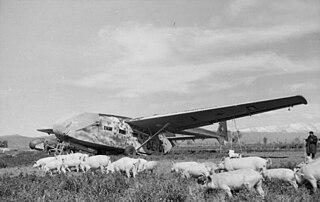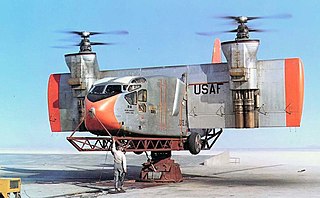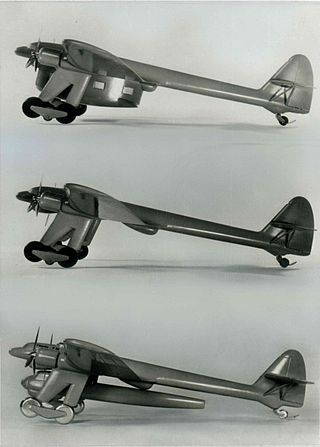
The Gotha Go 242 was a transport glider used by the Luftwaffe during World War II. It was an upgrade over the DFS 230 in both cargo/troop capacity and flight characteristics. It saw limited combat action. There were multiple glider variants, and it became the basis for a transport aircraft, the: Gotha Go 244.

The C-82 Packet is a twin-engine, twin-boom cargo aircraft designed and built by Fairchild Aircraft. It was used briefly by the United States Army Air Forces and the successor United States Air Force following World War II.

The Fairchild C-119 Flying Boxcar was an American military transport aircraft developed from the World War II-era Fairchild C-82 Packet, designed to carry cargo, personnel, litter patients, and mechanized equipment, and to drop cargo and troops by parachute. The first C-119 made its initial flight in November 1947, and by the time production ceased in 1955, more than 1,100 had been built.

The Boeing C-108 Flying Fortress was an American transport aircraft used during World War II. Four were converted from B-17 Flying Fortress heavy bombers.

The Hiller X-18 was an experimental cargo transport aircraft designed to be the first testbed for tiltwing and V/STOL technology.

The Ling-Temco-Vought (LTV) XC-142 is a tiltwing experimental aircraft designed to investigate the operational suitability of vertical/short takeoff and landing (V/STOL) transports. An XC-142A first flew conventionally on 29 September 1964, and completed its first transitional flight on 11 January 1965 by taking off vertically, changing to forward flight, and finally landing vertically. Its service sponsors pulled out of the program one by one, and it eventually ended due to a lack of interest after demonstrating its capabilities successfully.

The AIDC XC-2 was a prototype civil transport aircraft designed in the 1970s in Taiwan. It was a high-wing monoplane powered by two turboprop engines. The main undercarriage was carried in sponsons on either side of the boxy fuselage, maximising internal space.
The Savoia-Marchetti SM.105 was a projected Italian four-engine military and civil transport aircraft of the post-World War II period.

The Fairchild 71 was an American high-wing monoplane passenger and cargo aircraft built by Fairchild Aircraft and later built in Canada by Fairchild Aircraft Ltd. (Canada) for both military and civilian use as a rugged bush plane.

The PIK-5 was a training glider produced in Finland in the 1940s, and 1950s, equipping the country's gliding clubs with an aircraft greater in performance than primary gliders but less than competition sailplanes.

The Chase XC-123A was an experimental transport aircraft developed by Chase Aircraft. The first jet-powered transport built for the United States Air Force, it was intended for use as a high-speed transport for high-priority cargo and personnel. The XC-123A was determined to have insufficient advantages over existing types in service, and did not go into production. The sole prototype was converted into the piston-powered Stroukoff YC-123D to evaluate boundary layer control systems.

The Fairchild AU-23 Peacemaker is an American armed gunship, counter-insurgency, utility transport version of the Pilatus PC-6 Porter for the United States Air Force. A total of 35 were built under license in the United States by Fairchild Industries, for use during the Vietnam War in the early 1970s. All aircraft were later sold to the Royal Thai Air Force.

The Kreider-Reisner XC-31 or Fairchild XC-31 was an American single-engined monoplane transport aircraft of the 1930s designed and built by Kreider-Reisner. It was one of the last fabric-covered aircraft tested by the U.S. Army Air Corps. Designed as an alternative to the emerging twin-engined transports of the time such as the Douglas DC-2, it was evaluated by the Air Corps at Wright Field, Ohio, under the test designation XC-941, but rejected in favor of all-metal twin-engined designs.

The Fieseler Fi 333 was a prototype transport aircraft developed by Fieseler in 1942, and backed by the Luftwaffe.
The Wier RDW-2 Draggin' Fly was a homebuilt light aircraft, designed in the United States in the 1970s, aimed at fairly inexperienced builders and flyers. Plans were available but only one was built.
The ViS Sprint is a pusher configuration, pod-and-boom two-seat ultralight, designed and built in the Ukraine in the mid-2000s. It can serve as an agricultural spraying aircraft.
The Skyline SL-122 Bdzhilka is a twin engine agricultural spray aircraft designed and built in Ukraine and first flown in 2010.

A modular aircraft or pod plane is a design principle for an aircraft where the payload carrying section can be routinely detached from, and reattached to, the rest of the aircraft. It can be compared to the function of intermodal shipping containers.
The Curtiss-Reid Courier was designed in Canada in 1931 as a specialist, non-passenger carrying, mailplane capable of maintaining services in Canada's hard winters. The 1930s depression led to the end of government subsidised airmail contracts and only one prototype flew. It was lost in 1933 during preparations for a private, long distance flight.

The Albatros L 83 Adler was a small, fast transport aircraft for passengers, mail or other cargo, flown in Germany in 1931. Two were built.

















